List of Harrier operators
This is a list of operators of the Harrier family of military V/STOL aircraft, designed and built in the United Kingdom and United States of America. The members of family were Hawker Siddeley P.1127, Hawker Siddeley Harrier (AV-8A), British Aerospace Sea Harrier, McDonnell Douglas AV-8B Harrier II, and British Aerospace Harrier II. As of 2012, only the AV-8B and Sea Harrier remain in active service.
P.1127 / prototype / evaluation aircraft operators

- Aeroplane and Armament Experimental Establishment P.1127 and Kestrel trials and evaluation
- Royal Air Force
- Central Fighter Establishment – Kestrel (P.1127) Evaluation Squadron (also known as the Tripartite Evaluation Squadron), nine Kestrel aircraft allocated for evaluation in 1965. One aircraft was lost in an accident, six aircraft later passed to the United States Army, one to the RAE and one to Hawker-Siddeley for further trials.[1]
- Royal Aircraft Establishment P.1127 and Kestrel trials and evaluation.[1]

- United States Army
- (aircrew participated in both the Tri-partite Evaluation Squadron and as part of the American XV-6A Tri-service evaluation team. Had three Kestrel aircraft allocated after the evaluation at West Raynham and also acquired the three allocated to Germany. Four later transferred to the United States Air Force and two to the National Aeronautics and Space Administration).[2]
- United States Air Force
- (aircrew participated in both the Tri-partite Evaluation Squadron and as part of the American XV-6A Tri-service evaluation team but had no aircraft allocated after the evaluation at West Raynham, four former United States Army aircraft operated for trials).[2]
- United States Navy
- (aircrew participated in both the Tri-partite Evaluation Squadron and as part of the American XV-6A Tri-service evaluation team but had no aircraft allocated after the evaluation).[2]
- NASA
- operated two former United States Army Kestrels.[2]

- German Air Force
- (aircrew participated in the Tri-partite Evaluation Squadron, three allocated Kestrel aircraft not delivered and passed to United States Army)[2]
First generation Harrier operators

- Indian Navy - Indian Naval Air Arm
- Indian Naval Air Squadron 552
- Operated the Harrier T.60 for Sea Harrier training, with two T4(I) as replacements.[3]
- Indian Naval Air Squadron 552
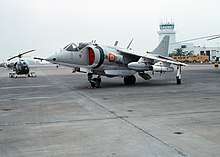
A Spanish Navy AV-8S Matador aircraft
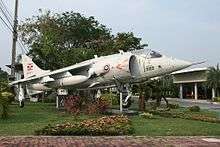
Thailand Navy AV-8S Matador
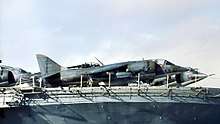
United States Marine Corps AV-8A of VMA-231 in 1980

- Spanish Navy
- No. 008 Escuadrilla – AV-8S and TAV-8S Matador.[4]

- Royal Thai Navy
- Squadron 1 Wing3 (HTMS Chakri Naruebet Flying Unit) – AV-8S and TAV-8S.[4] By 1999, only one aircraft of the 10 former Spanish aircraft received was believed to be airworthy because of lack of available spares.[5] In 2006 the Harrier was retired from service.[6]
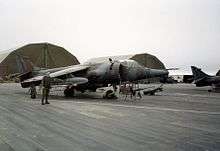
Harrier GR.3 of 1453 Flight at Stanley Airport in 1984

- Royal Air Force
- No. 1 Squadron RAF
- re-equipped with Harrier GR.1s between July and October 1969 at RAF Wittering. It started to replace its first generation Harriers with Harrier GR.5s in 1988, discarding its last GR.3 on 31 March 1989.[7]
- No. 3 Squadron RAF
- formed at RAF Wildenrath with the Harrier GR.1A on 1 January 1971, moving to RAF Gütersloh in 1977. It re-equipped with Harrier GR.5s in 1989.[8]
- No. 4 Squadron RAF
- converted to HarrierGR.1s at RAF Wittering in early 1970, moving to Wildenrath in Germany in June that year. It moved to RAF Gütersloh in January 1977 and replaced its GR.3s with Harrier GR.7s in 1990.[9]
- No. 20 Squadron RAF
- reformed at RAF Wittering in October 1970, moving to Wildenrath later that year. It disbanded in February 1977, with its aircraft being shared between the other two Germany based squadrons.[10]
- No. 233 Operational Conversion Unit RAF
- No. 1417 Flight RAF
- Deployed to Belize from 1980 to 1993.[15]
- No. 1453 Flight RAF
- Deployed to Stanley, in the Falkland Islands from August 1983 to June 1985.[16]
- No. 1 Squadron RAF
- Royal Navy - Fleet Air Arm
- 899 Naval Air Squadron
- operated the Harrier T.4A and T.4N for training purposes for the Sea Harrier.[3]
- 899 Naval Air Squadron
Sea Harrier operators

A Sea Harrier FRS.51 of INAS 300 awaiting launch clearance from INS Viraat in 2007
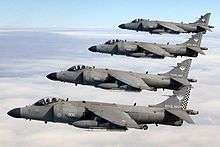
A section of four Sea Harrier FA.2s of 801 Naval Air Squadron

- Indian Navy - Indian Naval Air Arm – Sea Harrier F.52
- Indian Naval Air Squadron 300
- 'White Tigers'
- Indian Naval Air Squadron 300

- Fleet Air Arm – Sea Harrier FRS.1 and Sea Harrier F(A).2
- 800 Naval Air Squadron
- disbanded 2006
- 801 Naval Air Squadron
- disbanded 2006
- 809 Naval Air Squadron
- disbanded 1982
- 899 Naval Air Squadron
- disbanded 2006
- 800 Naval Air Squadron
McDonnell Douglas AV-8B Harrier II operators
.jpg)
An AV-8B Plus of the Spanish Navy in 2009
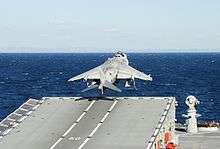
An Italian AV-8B launches from the carrier Cavour

- Italian Navy
- 14 AV-8B Plus and 2 TAV-8B Harrier IIs in service as of December 2010.[21]
- Gruppo Aerei Imbarcati – "The Wolves"
- 14 AV-8B Plus and 2 TAV-8B Harrier IIs in service as of December 2010.[21]

- Spanish Navy
- 16 EAV-8B Plus and 1 TAV-8B aircraft operational as of December 2010.[21]
- 09th Squadron
- 16 EAV-8B Plus and 1 TAV-8B aircraft operational as of December 2010.[21]

- United States Marine Corps
- The Marine Corps currently retains 126 AV-8B and TAV-8B aircraft, with only 80 Harrier aircraft in active service as of 2018. Each fighter squadron operates 16 AV-8B Harrier jets. The Marine Corps currently plans to have all squadrons transitioned to or start to transition to the F-35 platform by 2026.[22]
BAE Systems Harrier II operators
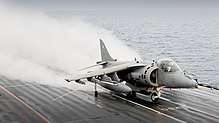
A Harrier GR.9 powers for launch from HMS Ark Royal

- Royal Air Force
- (1989–2011) – BAE Systems Harrier II GR.5 / GR.5a / GR.7 / GR.7a / GR.9 / GR.9a / T.10 / T.12
- No. 1 Squadron
- No. 3 Squadron (until 2006)
- No. 4 Squadron
- No. 20 Squadron (until 2010)
- Strike Attack Operational Evaluation Unit (SAOEU)
- (1989–2011) – BAE Systems Harrier II GR.5 / GR.5a / GR.7 / GR.7a / GR.9 / GR.9a / T.10 / T.12
- Royal Navy – Fleet Air Arm
- BAE Systems Harrier II GR.7 / GR.7a / GR.9 / GR.9a
- 800 Naval Air Squadron (2006–2007, 2010)
- Naval Strike Wing (2007–2010)
- BAE Systems Harrier II GR.7 / GR.7a / GR.9 / GR.9a
gollark: Anyway, in this case, the function is complicated somewhat by the need to actually handle calculator errors.
gollark: What?
gollark: So yes, it pops that first value from the stack as an accumulator.
gollark: ```haskellfold : Opfold = partialFunction <| \stack ctx (op, captured, needs) -> Stack.pop stack |> Result.fromMaybe (StackUnderflow 1) |> Result.andThen (\(start, newStack) -> List.foldl (\x res -> Result.andThen (\accStack -> Eval.runOp ctx op (x::accStack)) res) (Ok [start]) newStack)```
gollark: YES, IN THAT SPECIFIC CASE.
References
- Notes
- Citations
- Mason 1991, pp. 419–420.
- Evans, Andy (1998). BAE / McDonnell Douglas Harrier. Ramsbury, UK: The Crowood Press. ISBN 1-86126-105-5.
- Sturtivant 2004, pp. 80–90.
- Nordeen, Lon O. (2006). Harrier II: validating V/STOL. Naval Institute Press. ISBN 1-59114-536-8.
- Carpenter 2000, p. 302.
- "Archived copy". Archived from the original on 14 July 2012. Retrieved 26 October 2013.CS1 maint: archived copy as title (link)
- Jackson 1991, pp. 89–90.
- Jackson 1991, p. 90.
- Jackson 1991, p. 91.
- Jackson 1991, p. 92.
- Jackson 1991, p. 89.
- "20 Squadron" Archived 3 March 2016 at the Wayback Machine. Royal Air Force. Retrieved 2 March 2011.
- Evans 1998, p. 37.
- Evans 1998, p. 31.
- Sturtivant 2007, p. 122.
- Sturtivant 2007, p. 123.
- Jackson 1991, pp. 99–100.
- Jackson 1991, p. 98.
- Jackson 1991, p. 99.
- Jackson 1991, p. 100.
- "Directory: World Air Forces". Flight International, 14–20 December 2010. pp. 19, 25, 29.
- "2018 Marine Aviation Plan" (PDF). Marines.mil. 2018.
- Affairs, Story by 13th Marine Expeditionary Unit Public. "Essex ARG 13th MEU with embarked F35B enters Central Command". www.public.navy.mil. Retrieved 15 November 2018.
- "VMA-513 draws end to 69 years of service". Marine Corps Air Station Iwakuni, Japan. Retrieved 15 November 2018.
- Bibliography
- Carpenter, William M.; Wiencek, David G. (2000). Asian Security Handbook 2000. M. E. Sharpe. ISBN 978-0-7656-0715-7.
- Evans, Andy. BAe/McDonald Douglas Harrier. Ramsbury, UK: The Crowood Press, 1998. ISBN 1-86126-105-5.
- Jackson, Paul. "British Aerospace/McDonnell Douglas Harrier". World Air Power Journal, Volume 6, Summer 1991. pp. 46–105.
- Mason, Francis K. Hawker Aircraft since 1920. London: Putnam, 1991. ISBN 0-85177-839-9
- Sturtivant, Ray. Fleet Air Arm Fixed-Wing Aircraft since 1946. Tonbridge, Kent, UK: Air-Britain (Historians), 2004. ISBN 978-0-85130-283-6.
This article is issued from Wikipedia. The text is licensed under Creative Commons - Attribution - Sharealike. Additional terms may apply for the media files.